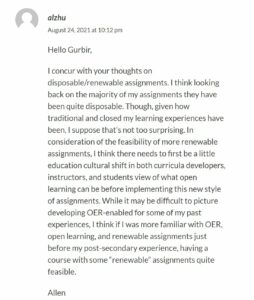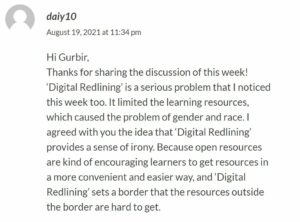Part 1: Evidence and Reflection of my Learning in EDCI 339
I will be reflecting on and providing evidence of my learning throughout this course by explaining in detail on how I met the following learning outcomes:
- Describe the potential of human-centered learning in distributed and open learning contexts
- Explore and engage with the current literature on the distributed and open education movement and;
- Examine and reflect upon the potential for equitable access for all learners in online and open learning contexts
1. Describe the potential of human-centered learning in distributed and open learning contexts
Throughout the length of this course, I have taken part in several activities that have helped me reach this outcome and help flesh out my understanding of human-centered learning in both distributed and open learning contexts.
Specifically, in my topic 1 post I mentioned that in an ‘open’ context the learning is more self-directed and flexible in its delivery, whereas a distributed learning model is a more rigid and structured methodology when it comes to delivering education within the confines of an organization/educational institute.
Topic 2’s reading “Openness and Education: A beginners’ guide” was also a great resource for me when meeting this learning outcome as it built upon Topic 1’s materials. My topic 2 post explores a more human-centered approach concerning ‘open’ access technologies and resources that are made available to students, or more specifically should be made available to students. I also discussed the benefits associated with an open learning context as it allows for educational materials to be made available asynchronously which directly allows for students to access these materials at a time which works best for them. By allowing for students to create their own schedules by delivering educational materials asynchronously you are allowing them to put forward their best work as they are not bound by the same constraints faced with participation in reoccurring scheduled lectures.
This comment below left by my Pod peer Allen on my Topic 2 discussion post also supports my thoughts on the beneficial aspects of open access textbooks in the context of making educational materials more easily accessible for those seeking an education.

From completing these activities, I learned new concepts; the most notable of which being human-centered learning, blended learning, and open access educational resources. It’s also really opened my eyes to the financial barriers which are imposed on students and how they take different forms in each methodology. In the case of ‘open’ learning that first big financial barrier is in sourcing the technology from which to access educational materials from and in a more distributed environment that financial hurdle is associated with the various ‘pay-walls’ students find themselves faced with (i.e., textbook pricing)
The things I learned matter to me because as a student before this course I really did not have a strong notion of the utilities associated with both distributed and open learning models. Now armed with this knowledge I am better able to evaluate my overall learning experience and find new ways that will keep me better engaged and motivated in my coursework.
2. Explore and engage with the current literature on the distributed and open education movement
Topic 4’s reading “Defining OER-enabled Pedagogy” helped me in reaching this learning outcome as it explored more conceptual ideas regarding the efficacy of OER-enabled pedagogy and its acceptance by students as an alternative to the current norm of distributed learning. What I found to be most interesting was the four-part test mentioned within this article in determining if an assignment fit the requirements to be labeled as “renewable” (essentially a litmus test in deciding if it fit within the context of being ‘open’). In my topic 4 post I go on to ask the question of, “In what university faculties would ‘renewable’ assignments be a more feasible/improved upon practice when delivering coursework?”. This sparked some interesting/introspective responses from my pod members which I have included below as their responses helped in clarifying my thoughts on this matter.


The persona (shown below) that we as a group created for our Digital Pod Project was best suited for a distributed model with the option of asynchronous coursework as he needs to achieve the accreditation from a post-secondary institute in order to progress in his career as a teacher while also studying from abroad. A distributed environment also allows for the discussion and exploration of a topic within a relatively small cohort of like-minded individuals. The same can’t be said for an ‘open’ environment as there is a vast number of individuals who may be accessing the materials and as a result your chance to contribute to a discussion may get lost in the storm of already existing platforms and their users.

From completing these activities, I learned that it really depends on an individuals’ personal circumstances on whether or not a distributed or open learning environment is best suited for their needs. Essentially there is no one size fits all solution to learning styles and that it’s also okay to take elements from both distributed and open methodologies to form a blended style of learning as we do not need to conform to a self-imposed rigidity in how we choose to teach or learn.
The things I learned matter to me because as a student how you learn is just as important if not more important than the material you cover as it directly impacts your retention of said material. If you are attempting to grasp concepts in a learning methodology that is not best suited for your needs you will end up doing yourself a disservice by not putting yourself in the best possible position to learn.
3. Examine and reflect upon the potential for equitable access for all learners in online and open learning contexts
Topic 3’s reading, “Digital Redlining, Access, and Privacy” helped in growing my understanding on the current limitations associated with equitable access in online/open learning environments. Specifically, within my topic 3 post I go into detail on how the practice of digital redlining is predatory in nature as it exerts influence over the naivety of students who believe that they are receiving an honest educational experience when the reality is a learning environment filled with proverbial police tape barring entry from beneficial sources of information for any number of reasons (i.e., administrative policies, etc.).
My pod member Sam also brought up a more specific example in his blog post (Sam’s topic 3 post) regarding equitable access to educational materials by touching on accessibility issues faced by communities that are hard to reach with the existing infrastructure in place, namely Aboriginal communities. Below are my thoughts reflecting and commenting on his post.

From completing these activities, I learned that issues regarding accessibility to educational materials are much more nuanced than I previously thought as individuals all have varying levels of technological literacy and information literacy within a specific context. Those varying levels means that accessibility to materials is not as easy as placing a computer with an internet connection in front of a user because of that existing divide due to various socioeconomic and demographic factors that come into play.
The things I learned matter to me because everyone should have the right to explore any given topic in an academic setting without being subjected to filters. These imposed limitations are what prevent the access to materials that would have otherwise been beneficial towards a students’ educational experience.
Part 2: “Showcase” Blog Post
Description of Changes:
I selected this post as I wanted to update/add to my reflection because of Yifei’s comment regarding how digital redlining is a practice that can exacerbate discriminatory practices due to a person’s gender, race, or socioeconomic background. My original blog post goes into detail regarding the implications of accessibility in the context of digital redlining but only briefly touched on the aspect of equity amongst student’s and I feel that this is something that can be further expanded upon, namely the correlation between OERs and digital redlining.
Yifei’s comment:
